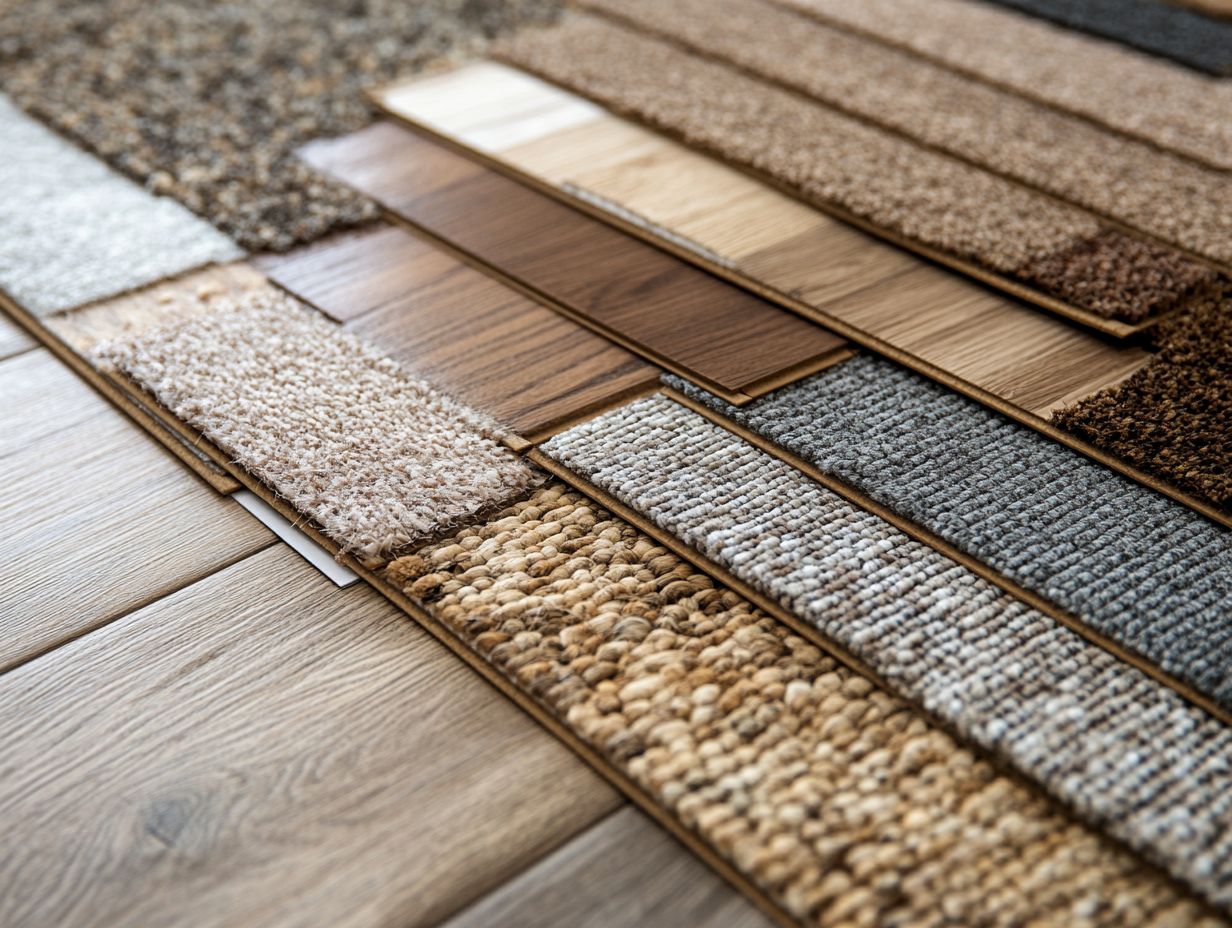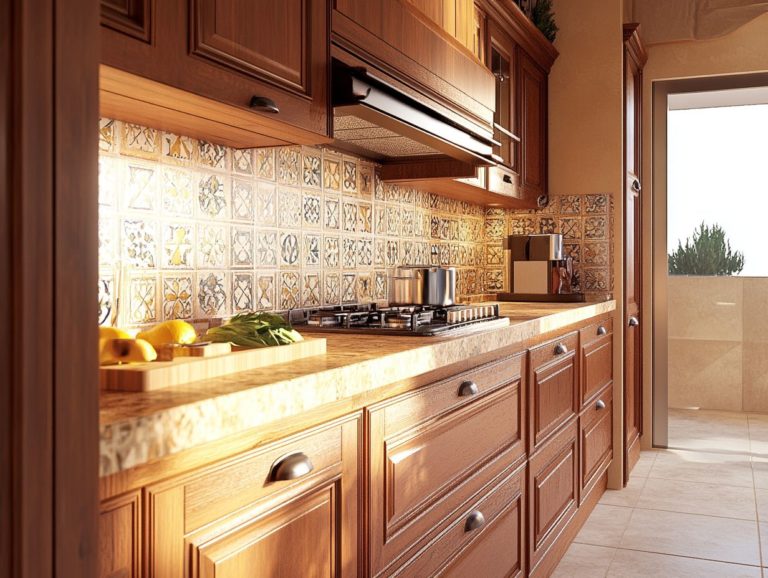Understanding the Pros and Cons of Different Flooring Materials
Selecting the ideal flooring material can transform your space. However, the variety of options can be daunting.
Each material has its benefits, like durability and visual appeal. They also have downsides, including cost and environmental impact.
This article explores common flooring types, weighing their pros and cons. This will help you make an informed decision.
Whether you’re renovating or building new, understanding these factors will help you choose the best flooring for your home.
Contents
- Key Takeaways:
- Overview of Common Types
- Benefits of Different Flooring Materials
- Drawbacks of Different Flooring Materials
- Choosing the Right Flooring Material for Your Space
- Frequently Asked Questions
- What are the most common types of flooring materials?
- What are the pros and cons of hardwood flooring?
- How does laminate flooring compare to hardwood?
- What are the benefits of choosing vinyl flooring?
- What should I consider when choosing between tile and carpet?
- What are the pros and cons of stone flooring?
Key Takeaways:

Different flooring materials offer unique benefits, such as durability and design options. But they can also have drawbacks like cost and environmental concerns.
Consider maintenance, design, and health impacts when choosing flooring. Understanding the pros and cons helps you find the best option for your needs.
Overview of Common Types
When choosing flooring, many options can enhance your décor. From hardwood to laminate, each type has its characteristics.
If you prioritize durability, concrete is a solid choice. Vinyl offers a stylish and budget-friendly alternative.
Tile, cork, and bamboo flooring each have unique advantages. Explore these choices for the best renovation results.
Benefits of Different Flooring Materials
Exploring flooring materials reveals options that can greatly impact your renovation. Each type has its benefits and drawbacks.
Hardwood is known for its elegance and durability. Laminate is a budget-friendly alternative that looks like wood.
For low maintenance, concrete is an ideal choice. Vinyl is great for areas prone to spills, thanks to its moisture resistance.
Tile is versatile and easy to customize. Cork and bamboo are eco-friendly options that are also resilient.
With so many choices, the perfect flooring is ready to elevate your home!
Durability and Maintenance
When choosing flooring, consider durability and maintenance for long-term satisfaction. Each option has unique requirements.
Hardwood may need refinishing every few years. Laminate only requires a quick sweep and mop, perfect for busy families.
Concrete lasts decades with minimal upkeep, needing occasional sealing. Vinyl stands up to spills and requires just a damp mop.
Tile is easy to clean with standard tile cleaner. Cork and bamboo need specific products to maintain their textures and colors.
Design and Aesthetics

The design and aesthetic appeal of flooring materials are crucial in shaping the overall ambiance of your living space.
Each flooring type can significantly influence the mood and style of your interiors, crafting distinctive atmospheres through a captivating array of colors, patterns, and textures.
For instance, hardwood floors can elevate both rustic and contemporary themes with their rich, natural hues. They add warmth and sophistication.
Laminate flooring, on the other hand, opens up a world of innovative designs. It effortlessly mimics everything from elegant ceramic tiles to luxurious stone finishes, allowing you to customize your environment without stretching your budget.
Concrete brings a sleek, urban edge that perfectly complements minimalist or modern décor. Vinyl’s adaptability makes it an excellent fit for both cozy farmhouse aesthetics and dynamic urban chic.
The unique properties of tile, cork, and bamboo provide opportunities to make your space feel warm and inviting. They enable you to create elegant interiors that truly resonate with your individual tastes.
Drawbacks of Different Flooring Materials
While there are countless flooring options that come with remarkable benefits, it’s essential to consider the drawbacks of each material to make the best choice.
Hardwood flooring, although undeniably beautiful, can be prone to scratches and moisture damage. This makes it less suitable for homes with pets or high humidity levels.
Laminate flooring is budget-friendly, but it might not deliver the same authentic feel as real wood. It can also be susceptible to warping.
Concrete flooring can feel unforgivingly cold underfoot and may require sealing to maintain its condition. Meanwhile, vinyl flooring sometimes emits VOCs, which could pose concerns for those with asthma or allergies.
Tile flooring can be hard and chilly. Cork and bamboo may struggle in heavy moisture environments, presenting additional considerations for you to keep in mind.
Cost and Installation Challenges
Cost and installation challenges are pivotal factors to consider when selecting the right flooring type for your space. They can vary significantly across different materials.
Hardwood flooring looks stunning but can stretch your budget. In contrast, laminate flooring gives you the same wood look without breaking the bank. Its easy installation is perfect for DIY enthusiasts.
Concrete, with its rugged charm, can quickly become expensive if you need professional help to achieve optimal results. Vinyl flooring is another contender, celebrated for its affordability and straightforward installation, making it a wise choice for those who are cost-conscious.
Tile flooring demands careful handling and can lead to considerable installation expenses. Cork and bamboo present unique textures and sustainable options. These generally fall within a moderate budget but can vary significantly based on availability and sourcing.
Health and Environmental Concerns
Health and environmental concerns are increasingly shaping your choices when it comes to flooring materials, so it’s essential to grasp their impacts.
While hardwood flooring often touts eco-friendliness, its sourcing practices might raise red flags about sustainability. When hardwood is extracted, it can contribute to deforestation, triggering severe repercussions for biodiversity and carbon emissions.
Laminate flooring may seem like a budget-friendly option, but it often contains adhesives that release volatile organic compounds (VOCs) into your living space. This can aggravate respiratory issues for those sensitive to allergens.
Concrete could be a solid choice thanks to its durable nature, but don’t overlook its significant carbon emissions during production. Vinyl flooring, infamous for its environmental footprint, can also compromise indoor air quality with VOC concerns.
Tile flooring, while lauded for its longevity, isn’t always the most sustainable option, depending on how it’s manufactured. However, you can explore eco-friendly alternatives like cork and bamboo, celebrated for their renewability.
Just be sure to check that these materials are treated without toxic chemicals to truly benefit your health and the environment.
Choosing the Right Flooring Material for Your Space

Choosing the right flooring material for your space involves several key factors, including style, usage, and environmental considerations. This creates a perfect harmony between look and functionality!
Start by evaluating the various flooring options available. Consider how they align with your design goals and practical needs. If moisture-resistant flooring is a top priority for you, vinyl or tile could be your best bets.
Durability might steer you toward hardwood or concrete flooring, especially in high-traffic areas. Don’t forget to consider pets or allergens that may influence your decision. You might prefer eco-friendly materials like cork or bamboo—options that elevate your space while promoting a healthier living environment.
Factors to Consider
When selecting flooring materials, consider several key factors to ensure your choice aligns with your lifestyle and preferences.
Durability is essential for high-traffic areas. Robust options like hardwood or laminate might be your best bet.
Moisture-resistant materials are crucial in spaces like kitchens and bathrooms. Vinyl or tile flooring is often more appropriate here.
Eco-friendly options are also important, especially if you have allergies or asthma. Materials like cork and bamboo can help minimize exposure to allergens and volatile organic compounds (VOCs), improving air quality.
It’s vital to evaluate the long-term maintenance needs associated with each flooring type. For instance, while hardwood looks beautiful, it requires periodic refinishing to maintain its charm.
Laminate also offers a similar look with significantly lower upkeep. Don’t forget to consider your region’s climate; in humid areas, selecting moisture-resistant options like engineered wood can help prevent warping.
Investing in sustainable materials not only supports environmental initiatives but can also enhance your home’s resale value.
By exploring various styles and adhering to these practical factors, you’ll arrive at a flooring choice that beautifully harmonizes functionality with your personal taste.
Frequently Asked Questions
What are the most common types of flooring materials?
The most common types of flooring materials include hardwood, laminate, vinyl, tile, carpet, and stone.
What are the pros and cons of hardwood flooring?

The pros of hardwood flooring include its durability, aesthetic appeal, and potential to increase home value. The cons include high cost, susceptibility to water damage, and potential for scratches and dents.
How does laminate flooring compare to hardwood?
Laminate flooring is a cheaper alternative to hardwood and is more resistant to scratches and water damage. However, it may not have the same look and can’t be refinished like hardwood.
What are the benefits of choosing vinyl flooring?
Vinyl flooring is affordable, easy to install, and highly resistant to water, stains, and scratches. It also comes in a wide range of designs and can mimic the look of other materials, including hardwood or tile.
What should I consider when choosing between tile and carpet?
Tile is more durable and easier to clean, while carpet offers more comfort and insulation. Consider the room’s function and your lifestyle when deciding between the two.
What are the pros and cons of stone flooring?
The natural beauty and durability of stone flooring are its main advantages. However, it can be quite expensive and may require frequent sealing and maintenance. It can also be cold and hard underfoot.
Ready to explore the perfect flooring for your space? Consult a flooring expert today!





